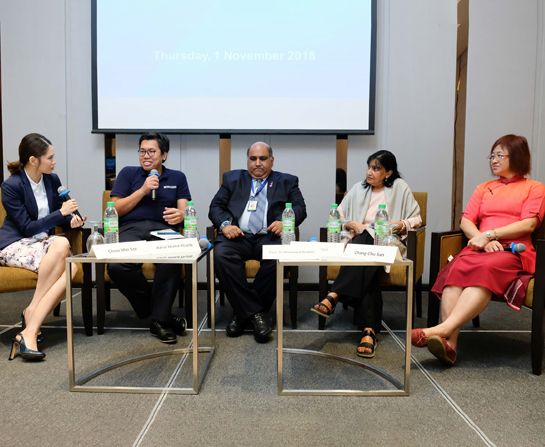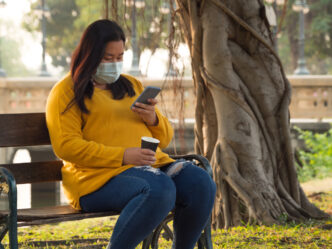WORDS HANNAH MAY-LEE WONG
As Malaysia’s new government announced Budget 2019, stakeholders across the country gritted their teeth and hoped for the best as they watched reality unfold before their eyes. One of the biggest items in our nation’s overall budget every year is no doubt the healthcare budget. It increases every year and 2019 is no exception with RM29bil allocated to health services – a 7.8 percent increase.¹
The increased allocation is welcome news because there are areas of our healthcare system that are still in need of improvement in terms of access and quality of treatment. One ofthese areas is cancer care. Cancer poses an enormous financial burden in many families, yet cancer patients face numerous challenges in gaining access to affordable public healthcare services.
On November 1, a group of opinion leaders in cancer care and advocacy – Dato’ Dr Ibrahim Wahid, Ranjit Kaur Pritam Singh and Azrul Mohd Khalib – discussed key recommendations for policy makers to consider for alleviating the unmet needs of metastatic cancer patients in our country.
BARRIERS TO BETTER CANCER CARE
Like most developing countries, a large number (nearly 40 percent) of cancer patients in Malaysia are diagnosed in the advanced or metastatic stage. This could be a contributing factor to the high mortality rates of cancer our country has been seeing. To make matters worse, public access to newer oncology treatments is poor. Consultant clinical oncologist, Dato’ Dr Ibrahim Wahid explained, “We have to wait at least one year for new medications to be approved by regulatory bodies in Malaysia, but this could go up to two or three years. Furthermore, once it’s approved in Malaysia, it takes approximately four years before these drugs are made available in government hospitals. This is a very long time compared to Japan and Germany, where the process takes only two to three months.”
“THERE ARE MANY STATES IN MALAYSIA – PAHANG, KUANTAN, TERENGGANU, KEDAH AND PERLIS – THAT HAVE A SHORTAGE OF CANCER EXPERTS AND CANCER CENTRES.”
“Although there is no cure for cancer, some breakthrough cancer medications can extend the lifespan of patients from months to years,” Dr Ibrahim revealed. “Yet, many options are still not available in government hospitals. Due to the delay in approval of new medications and further delay in getting them to public hospitals, there is a discrepancy in quality of treatment between public and private hospitals. Those who can afford private services get newer and better treatment options. Whereas those who opt for government hospitals do not benefit from cutting-edge technology in cancer therapy because they are not available to them.”
It certainly does not help that cancer therapy is very expensive. “A high number of patients go bankrupt as a result of paying for therapy. Some have resorted to selling their house and when they are gone, their family has to deal with the debt,” Dr Ibrahim expressed with worry.
Another pressing issue faced by our country is the lack of cancer specialists and facilities in many rural areas. “There are many states in Malaysia – Pahang, Kuantan, Terengganu, Kedah and Perlis – that have a shortage of cancer experts and cancer centres. Access to cancer care is very one-sided: urban areas, especially in the west coast such as Kuala Lumpur, have many cancer centres. Yet in the east coast, there are hardly any of these facilities. People living in the more rural areas will have to travel a long way just to get treated,” Dr Ibrahim said.
MAKING A CASE FOR CANCER PATIENTS
According to Dr Ibrahim, the budget for cancer care is low, especially when compared to the budget allocated for haematology and kidney patients in Malaysia. The reason for this, said Azrul Mohd Khalib, chief executive of the Galen Centre for Health & Social Policy, is because Malaysia is not investing enough in healthcare as an upper-middle income nation. “The World Health Organization (WHO) recommends that upper middle-income nations should spend around seven percent of their GDP on healthcare,” he explained. “In 2018, Malaysia only spent 4.3 percent of GDP on healthcare and of this, only 2.3 percent went into the public sector. It’s not because we can’t afford better services, it’s because we are under-funding it.”
“According to the WHO, non-communicable diseases (NCDs) account for 73-75 percent of deaths in Malaysia. Cancer is the third leading cause of death in that distribution. Despite this, Malaysia is under-funding not only the curative and therapeutic aspects in dealing with NCDs, but also the preventive aspects.
“The percentage of subsidies available to cancer patients is lower compared to kidney patients. For example, a kidney patient pays only RM650 for treatment that actually costs RM2,756. The remainder will be subsidized by the government. One of the reasons for this is because it is generally understood that a person with kidney disease would have a better outcome than a cancer patient; therefore, it’s good value for money. We need to make a case that it is worth investing in better treatment in order to improve the survival data,” Azrul added.
Azrul’s recommendations for improvement in public healthcare spending included higher taxes on specific items and a national health insurance. “If we want to get our public healthcare services on par with countries like the UK (where the national healthcare system is developed), we would need to introduce a national health insurance to free up funds. We should also impose higher taxes on tobacco and alcohol, and the funds from these taxes go directly into improving access to better healthcare among the public.”
A PATIENT’S PERSPECTIVE
Moving away from the budget and on to social support for cancer patients, attitude is a big issue when it comes to advanced disease. Ranjit Kaur Pritam Singh, a breast cancer survivor since 1998 and president of the Breast Cancer Welfare Association (BCWA) said, “With regards to advanced breast cancer, some people have the opinion that ‘you asked for it, because you waited too long’. Many are not aware that there are many women who were diagnosed in the early stages and got treated but developed metastatic breast cancer later on.”
Besides the unfair judgement and stigma placed upon advanced stage cancer patients, they are constantly faced with uncertainty and dilemma. “A question many patients ask themselves when going through cancer is: do I anticipate death, or do I focus on living life? If cancer patients get the best treatment, they can focus on living their life. If they don’t, they anticipate death. That is what’s on the mind of the majority of cancer patients, no matter if they choose public or private health care,” she shared.
Ranjit said that cancer patients may be limited in their choice of treatment options due to lack of knowledge or finances. “As breast cancer patients, we don’t get updates on new innovative treatment methods and clinical trials that are available. Upon diagnosis, if a patient goes to the right hospital, she might get access to these clinical trials. Or, those bold enough to go “doctor shopping” might be able to find ways around the system for helping themselves and getting into clinical trials. But those who only go to one doctor or can’t afford more than that will not get that chance.”
Creating better understanding and acceptance among the public is important for reducing the social stigma that comes with advanced cancer. In addition, patients need psychological and social support. According to Ranjit, in her experience of conducting workshops for women with advanced breast cancer, many families want to know: “Where do we get affordable treatment which enables our loved ones to live longer?” and “Where can we get financial resources? Can we get them from EPF, Socso or our insurance?”
Ranjit also believes that employers need to be educated so that they can provide good support for their employees struck with cancer. Lastly, there is a need for better insurance coverage and benefits for those with metastatic cancer.













